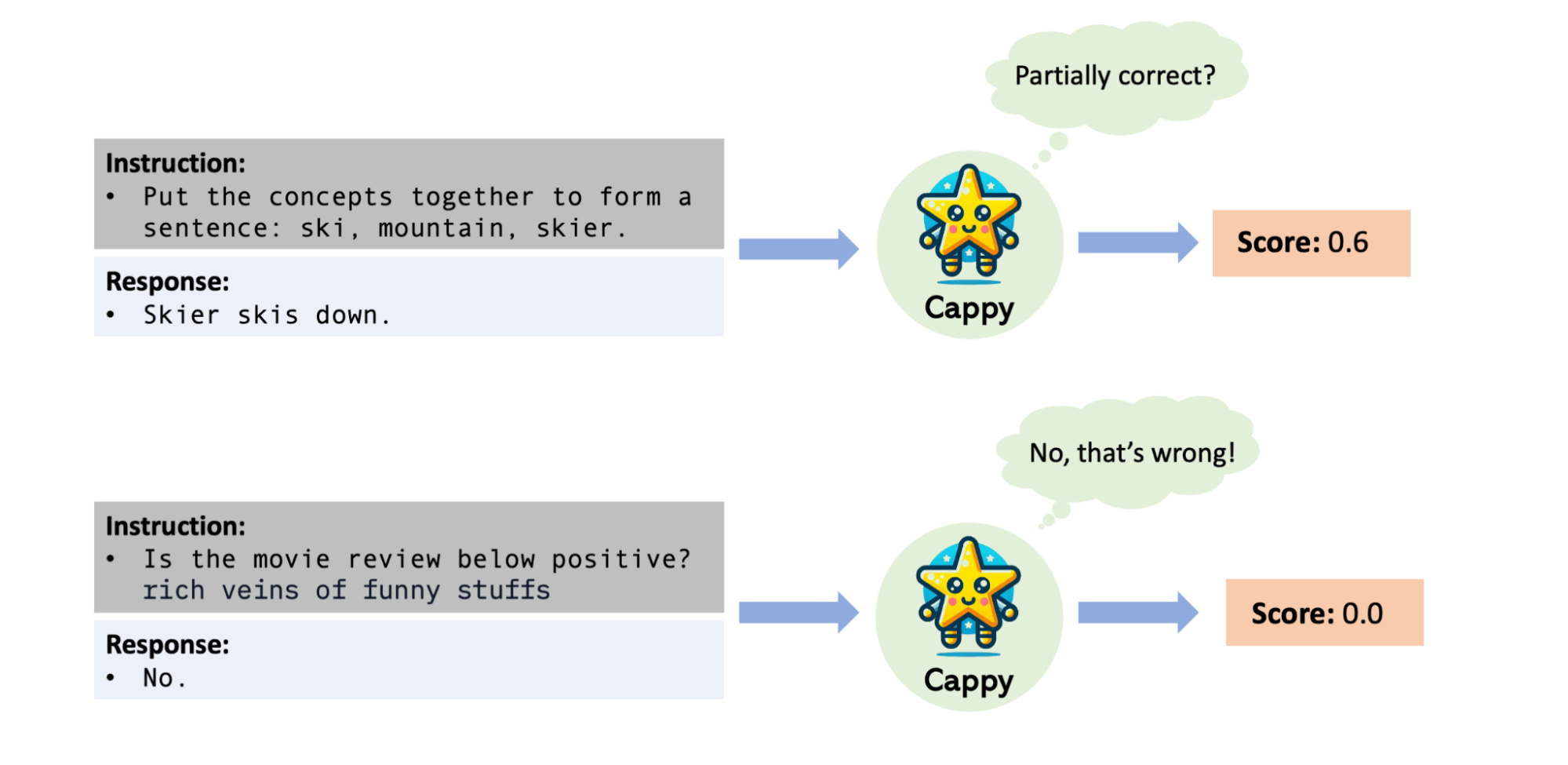
Cappy: Outperforming and boosting large multi-task language models with a small scorer
March 14, 2024
Posted by Yun Zhu and Lijuan Liu, Software Engineers, Google Research
We present Cappy, a small pre-trained scorer model that enhances and surpasses the performance of large multi-task language models. We evaluate the effectiveness of this pre-training scorer across a variety of complex tasks from PromptSource and Big-Bench.
Quick links
Large language model (LLM) advancements have led to a new paradigm that unifies various natural language processing (NLP) tasks within an instruction-following framework. This paradigm is exemplified by recent multi-task LLMs, such as T0, FLAN, and OPT-IML. First, multi-task data is gathered with each task following a task-specific template, where each labeled example is converted into an instruction (e.g., "Put the concepts together to form a sentence: ski, mountain, skier”) paired with a corresponding response (e.g., "Skier skis down the mountain"). These instruction-response pairs are used to train the LLM, resulting in a conditional generation model that takes an instruction as input and generates a response. Moreover, multi-task LLMs have exhibited remarkable task-wise generalization capabilities as they can address unseen tasks by understanding and solving brand-new instructions.

The demonstration of the instruction-following pre-training of multi-task LLMs, e.g., FLAN. Pre-training tasks under this paradigm improves the performance for unseen tasks.
Due to the complexity of understanding and solving various tasks solely using instructions, the size of multi-task LLMs typically spans from several billion parameters to hundreds of billions (e.g., FLAN-11B, T0-11B and OPT-IML-175B). As a result, operating such sizable models poses significant challenges because they demand considerable computational power and impose substantial requirements on the memory capacities of GPUs and TPUs, making their training and inference expensive and inefficient. Extensive storage is required to maintain a unique LLM copy for each downstream task. Moreover, the most powerful multi-task LLMs (e.g., FLAN-PaLM-540B) are closed-sourced, making them impossible to be adapted. However, in practical applications, harnessing a single multi-task LLM to manage all conceivable tasks in a zero-shot manner remains difficult, particularly when dealing with complex tasks, personalized tasks and those that cannot be succinctly defined using instructions. On the other hand, the size of downstream training data is usually insufficient to train a model well without incorporating rich prior knowledge. Hence, it is long desired to adapt LLMs with downstream supervision while bypassing storage, memory, and access issues.
Certain parameter-efficient tuning strategies, including prompt tuning and adapters, substantially diminish storage requirements, but they still perform back-propagation through LLM parameters during the tuning process, thereby keeping their memory demands high. Additionally, some in-context learning techniques circumvent parameter tuning by integrating a limited number of supervised examples into the instruction. However, these techniques are constrained by the model's maximum input length, which permits only a few samples to guide task resolution.
In “Cappy: Outperforming and Boosting Large Multi-Task LMs with a Small Scorer”, presented at NeurIPS 2023, we propose a novel approach that enhances the performance and efficiency of multi-task LLMs. We introduce a lightweight pre-trained scorer, Cappy, based on continual pre-training on top of RoBERTa with merely 360 million parameters. Cappy takes in an instruction and a candidate response as input, and produces a score between 0 and 1, indicating an estimated correctness of the response with respect to the instruction. Cappy functions either independently on classification tasks or serves as an auxiliary component for LLMs, boosting their performance. Moreover, Cappy efficiently enables downstream supervision without requiring any finetuning, which avoids the need for back-propagation through LLM parameters and reduces memory requirements. Finally, adaptation with Cappy doesn’t require access to LLM parameters as it is compatible with closed-source multi-task LLMs, such as those only accessible via WebAPIs.
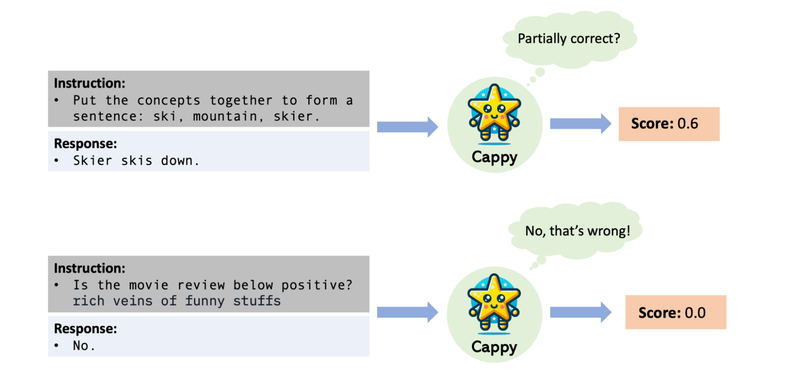
Cappy takes an instruction and response pair as input and outputs a score ranging from 0 to 1, indicating an estimation of the correctness of the response with respect to the instruction.
Pre-training
We begin with the same dataset collection, which includes 39 diverse datasets from PromptSource that were used to train T0. This collection encompasses a wide range of task types, such as question answering, sentiment analysis, and summarization. Each dataset is associated with one or more templates that convert each instance from the original datasets into an instruction paired with its ground truth response.
Cappy's regression modeling requires each pre-training data instance to include an instruction-response pair along with a correctness annotation for the response, so we produce a dataset with correctness annotations that range from 0 to 1. For every instance within a generation task, we leverage an existing multi-task LLM to generate multiple responses by sampling, conditioned on the given instruction. Subsequently, we assign an annotation to the pair formed by the instruction and every response, using the similarity between the response and the ground truth response of the instance. Specifically, we employ Rouge-L, a commonly-used metric for measuring overall multi-task performance that has demonstrated a strong alignment with human evaluation, to calculate this similarity as a form of weak supervision.
As a result, we obtain an effective regression dataset of 160 million instances paired with correctness score annotations. The final Cappy model is the result of continuous pre-training using the regression dataset on top of the RoBERTa model. The pre-training of Cappy is conducted on Google's TPU-v4, with RedCoast, a lightweight toolkit for automating distributed training.

Data augmentation with a multi-task LLM to construct a weakly supervised regression dataset for Cappy’s pre-training and fine-tuning.
Applying Cappy
Cappy solves practical tasks within a candidate-selection mechanism. More specifically, given an instruction and a set of candidate responses, Cappy produces a score for each candidate response. This is achieved by inputting the instruction alongside each individual response, and then assigning the response with the highest score as its prediction. In classification tasks, all candidate responses are inherently predefined. For example, for an instruction of a sentiment classification task (e.g., “Based on this review, would the user recommend this product?: ‘Stunning even for the non-gamer.’”), the candidate responses are “Yes” or “No”. In such scenarios, Cappy functions independently. On the other hand, in generation tasks, candidate responses are not pre-defined, requiring an existing multi-task LLM to yield the candidate responses. In this case, Cappy serves as an auxiliary component of the multi-task LLM, enhancing its decoding.
Adapting multi-task LLMs with Cappy
When there is available downstream training data, Cappy enables effective and efficient adaptation of multi-task LLMs on downstream tasks. Specifically, we fine-tune Cappy to integrate downstream task information into LLM predictions. This process involves creating a separate regression dataset specific to the downstream training data with the same data annotation process used to construct the pre-training data. As a result, the fine-tuned Cappy collaborates with a multi-task LLM, boosting the LLM's performance on the downstream task.
In contrast to other LLM tuning strategies, adapting LLMs with Cappy significantly reduces the high demand for device memory as it avoids the need for back-propagation through LLM parameters for downstream tasks. Moreover, Cappy adaptation does not rely on the access to LLM parameters, making it compatible with closed-source multi-task LLMs, such as the ones only accessible via WebAPIs. Compared with in-context learning approaches, which circumvent model tuning by attaching training examples to the instruction prefix, Cappy is not restricted by the LLM's maximum input length. Thus, Cappy can incorporate an unlimited number of downstream training examples. Cappy can also be applied with other adaptation methods, such as fine-tuning and in-context learning, further boosting their overall performance.
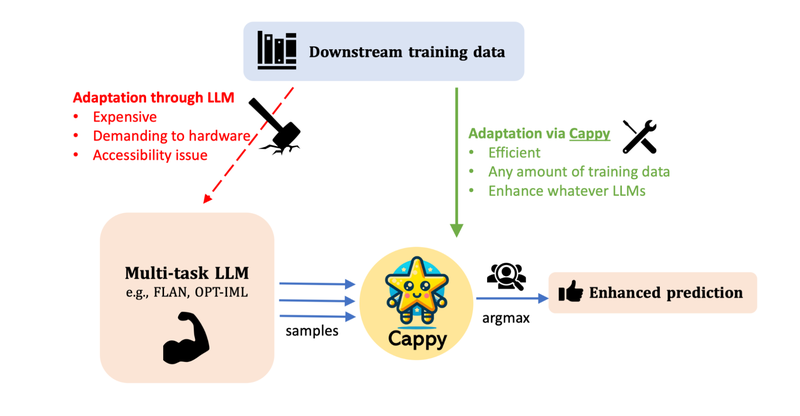
Downstream adaptation comparison between Cappy and approaches that rely on an LLM’s parameters, such as fine-tuning and prompt tuning. Cappy’s application enhances multi-task LLMs.
Results
We assess Cappy’s performance across eleven held-out language understanding classification tasks from PromptSource. We demonstrate that Cappy, with 360M parameters, outperforms OPT-175B and OPT-IML-30B, and matches the accuracy of the best existing multi-task LLMs (T0-11B and OPT-IML-175B). These findings highlight Cappy’s capabilities and parameter efficiency, which can be credited to its scoring-based pre-training strategy that integrates contrastive information by differentiating between high-quality and low-quality responses. On the contrary, previous multi-task LLMs depend exclusively on teacher-forcing training that utilizes only the ground truth responses.
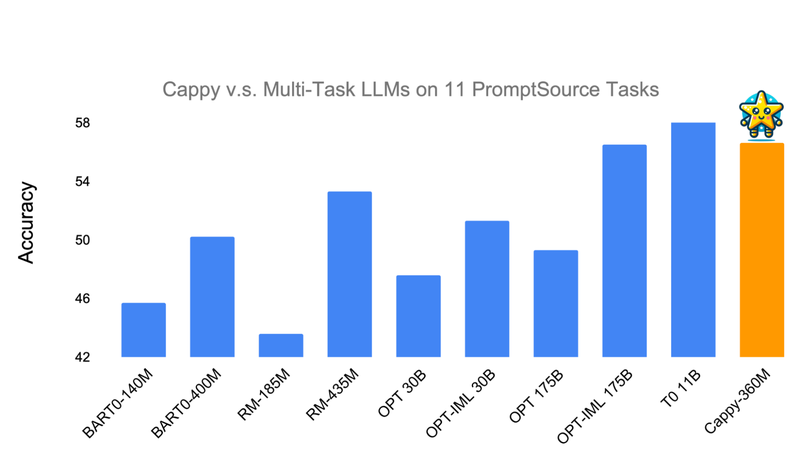
The overall accuracy averaged over eleven test tasks from PromptSource. “RM” refers to a pre-trained RLHF reward model. Cappy matches the best ones among existing multi-task LLMs.
We also examine the adaptation of multi-task LLMs with Cappy on complex tasks from BIG-Bench, a set of manually curated tasks that are considered beyond the capability of many LLMs. We focus on all the 45 generation BIG-Bench tasks, specifically those that do not offer pre-established answer choices. We evaluate the performance using the Rouge-L score (representing the overall similarity between model generations and corresponding ground truths) on every test set, reporting the average score across 45 tests. In this experiment, all variants of FLAN-T5 serve as the backbone LLMs, and the foundational FLAN-T5 models are frozen. These results, shown below, suggest that Cappy enhances the performance of FLAN-T5 models by a large margin, consistently outperforming the most effective baseline achieved through sample selection using self-scoring of the LLM itself.
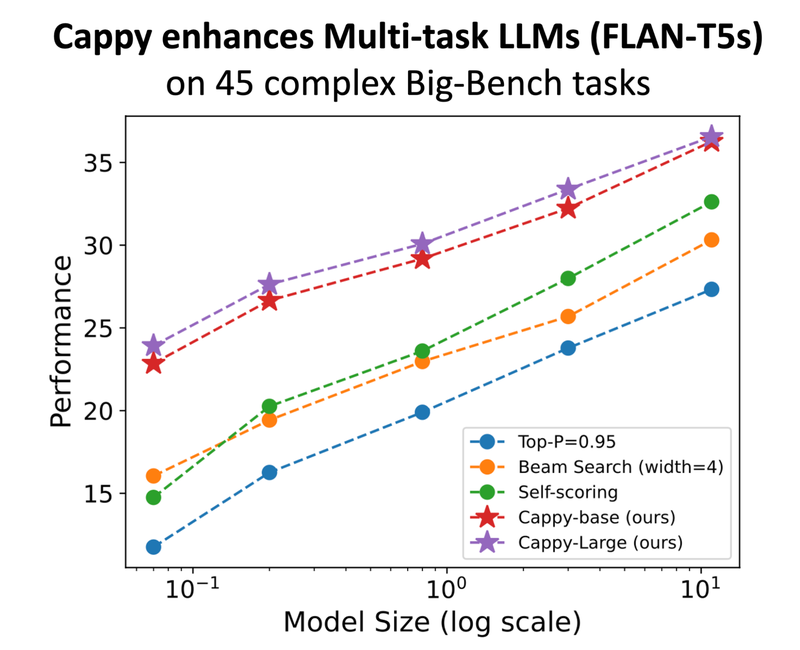
The averaged Rouge-L score over 45 complex tasks within BIG-Bench. The x-axis refers to FLAN-T5 models of different sizes. Every dashed line represents an approach working on FLAN-T5s. Self-scoring refers to using the cross-entropy of LLM to select responses. Cappy enhances the performance of FLAN-T5 models by a large margin.
Conclusion
We introduce Cappy, a novel approach that enhances the performance and efficiency of multi-task LLMs. In our experiments, we adapt a single LLM to several domains with Cappy. In the future, Cappy as a pre-trained model can potentially be used in other creative ways beyond on single LLMs.
Acknowledgments
Thanks to Bowen Tan, Jindong Chen, Lei Meng, Abhanshu Sharma and Ewa Dominowska for their valuable feedback. We would also like to thank Eric Xing and Zhiting Hu for their suggestions.


